People rarely answer calls from phone numbers they don’t recognize. But individuals are four times more likely to pick up the phone from an unrecognized caller if there’s a local number on the caller ID.
As a business operating from a single call center with prospects all over the country, establishing a local presence can make or break your success.
The solution? Non-fixed VoIPs.
What is a Non-Fixed VoIP?
VoIP (voice over internet protocol) uses internet technology to place calls without a physical phone line—an internet connection is the only requirement.
The major difference between a fixed VoIP and non-fixed VoIP is that a non-fixed VoIP is not attached to a physical address. Non-fixed VoIPs are commonly referred to as “virtual phone numbers.”
Since non-fixed VoIPs aren’t connected to a physical location, they can be associated with any local area—making them an ideal solution to serve customers in regions where your business doesn’t have a physical presence.
Non-fixed VoIPs can be used for call centers, remote teams, and even global communications.
5 Tools to Improve Non-Fixed VoIP
Non-fixed VoIPs aren’t perfect and come with their fair share of potential downsides. The following tools will help improve your non-fixed VoIP without sacrificing your goals and objectives.
#1 — RingCentral
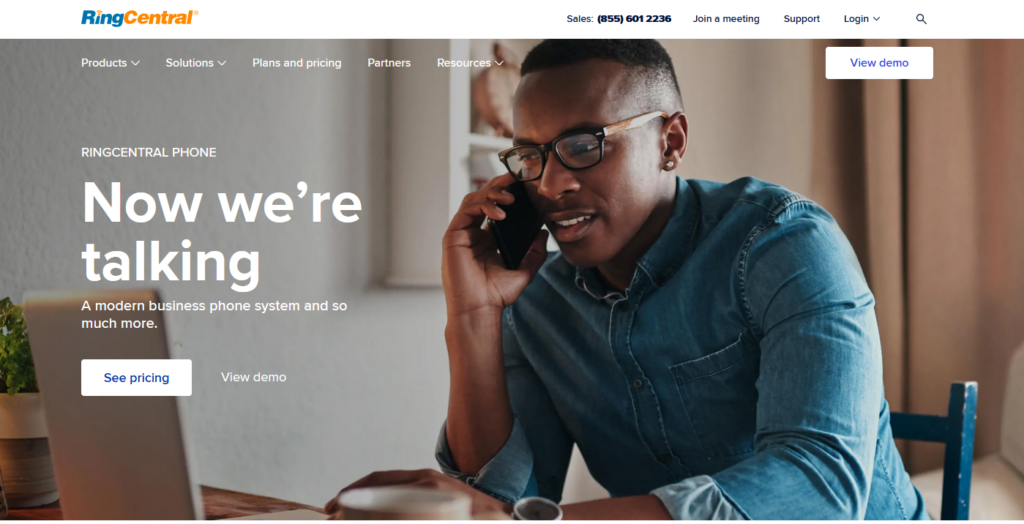
One major problem with non-fixed VoIPs is anonymity. Typically, an email is the only thing you need to sign up and manage your account.
But for business use, these “disposable” phone numbers can sometimes appear untrustworthy, even if the calls are coming from a local number.
That’s why I love RingCentral. It’s a traditional VoIP business phone solution that can address your non-fixed VoIP needs—but with extra perks.
Each user on your RingCentral plan will get a dedicated business phone number or toll-free number. You can always add local numbers or international numbers to your account at any time. Local numbers start as low as $4.99 per month. So you can still establish a local presence wherever your customers are located.
If you want to add more authenticity to your brand, try RingCentral for free with a 15-day trial.
#2 — Line2
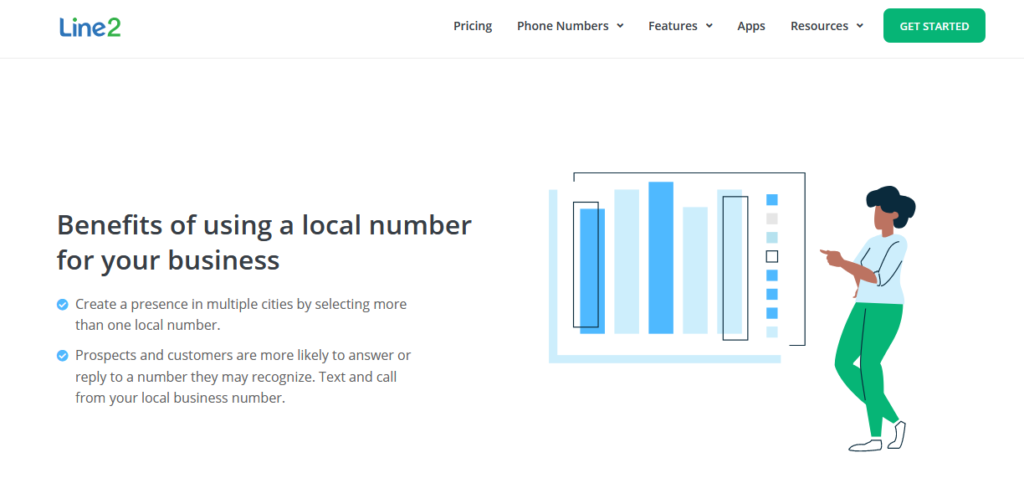
Line2 is a simple and affordable business phone system. It’s a popular upgrade for people currently using Google Voice or Skype for non-fixed VoIPs.
With Line2, you can transform your existing devices into a business phone line. Just download the Line2 mobile app, pick your number, and manage all of your business calls from the same device as your personal phone—it’s that easy.
The cool part about Line2 is that you can add multiple local numbers to your account. This makes it easy to communicate with customers in different locations without worrying about calling from an out-of-area number.
Line2 has plans for everyone. You can sign up and get just the basics, or choose an upgraded plan with advanced features like call recording, auto-attendant, voicemail transcriptions, call scheduling, advanced reporting, and more.
Overall, it’s definitely an upgrade from a basic non-fixed VoIP provider. Try it risk-free with a 30-day money-back guarantee.
#3 — CallHippo
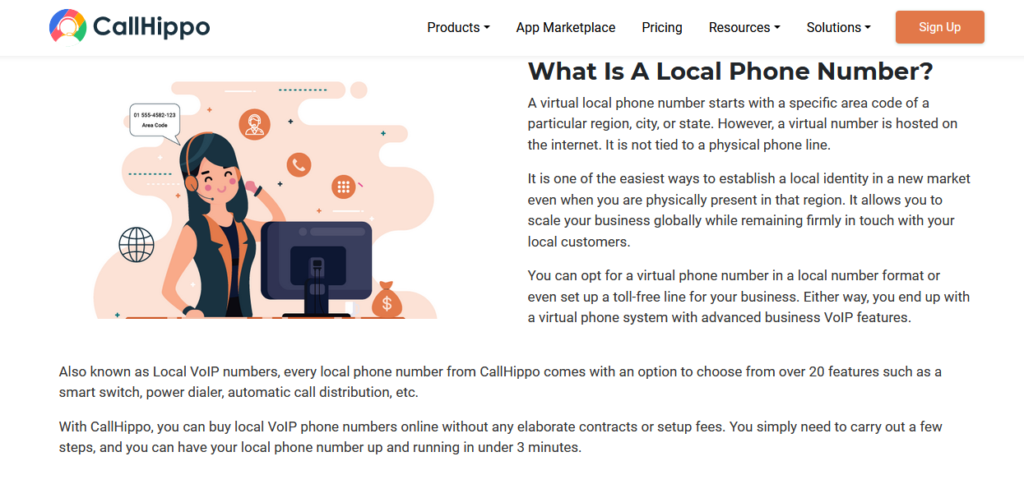
CallHippo isn’t the most popular or well-recognized name in the world of virtual phone systems. But it’s used by 5,000+ organizations worldwide, including some big names like Amazon and Honeywell.
The software is super easy to use. You can buy local or toll-free numbers in 50+ countries around the world, add multiple users to the same number, and start making and receiving calls within minutes.
With CallHippo, you’ll get a complete business phone system at an affordable price.
Some of the top features offered by this provider include call recording, skills-based routing, customized caller ID, internal team calling, call scripts, device forwarding, external number routing, and so much more.
The software integrates with 85+ business tools like Slack, Salesforce, HubSpot, Shopify, and more. It’s a great option for sales teams, support teams, and marketers.
#4 — Grasshopper
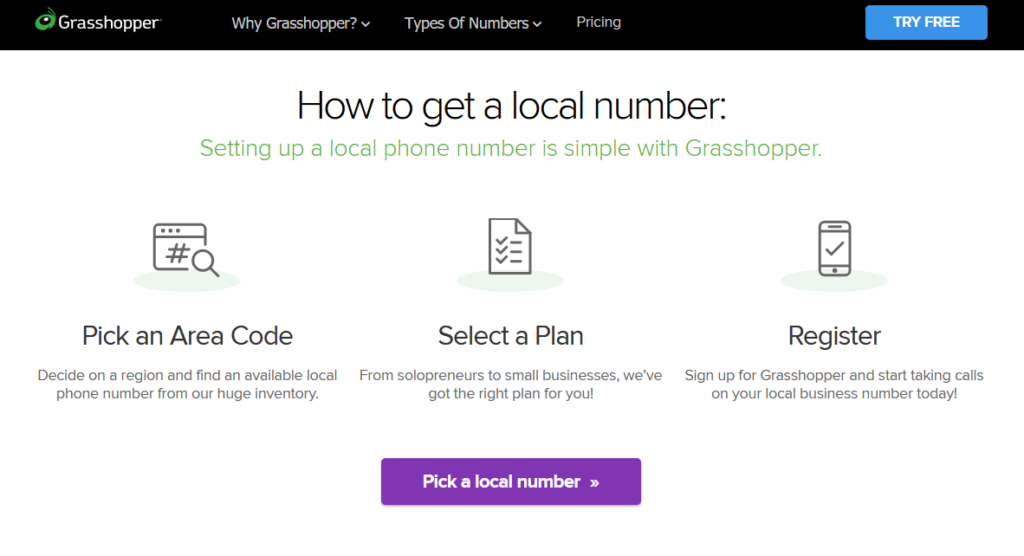
Grasshopper is another simple way to add a virtual business phone system to your personal devices.
With Grasshopper, you can do business from anywhere directly from their desktop and mobile apps.
Overall, it’s an affordable way to keep your personal number private while establishing a local phone number in different areas.
The software is designed for solo users and small businesses. There are three base plans to choose from, each starting with one, three, and five phone numbers, respectively. Additional phone numbers can always be added to your account post-purchase.
Adding a local number with Grasshopper is as easy as typing in an area code. In addition to calling, you can also text using your business phone number with Grasshopper.
Sign up today and try Grasshopper for free with a seven-day trial.
#5 — Phone.com
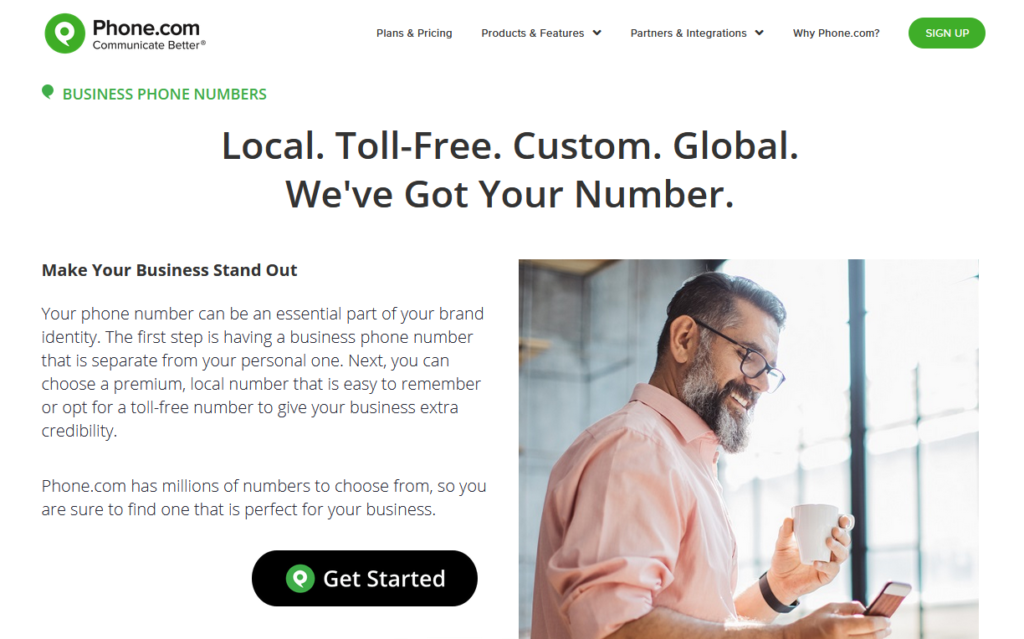
Phone.com is another popular business phone system that offers local, toll-free, vanity, and international numbers. The software is also an all-in-one communication platform with solutions for video conferencing, fax, text, and team collaboration.
Another unique standout of Phone.com is that it’s HIPAA-compliant, making it a popular choice for healthcare professionals.
I like Phone.com because they offer volume discounts to businesses that want to add lots of additional local numbers to their plan.
Adding up to 10 numbers starts at $4.99 per number. This drops down to $2.99 per number once you hit the 50-number mark. If you want 100+ local numbers, each one starts at $1.99.
This is an excellent way for businesses to connect with customers in different locations without breaking the bank. A 30-day money-back guarantee backs all Phone.com plans.
The Basics of Non-Fixed VoIP
Let’s get back to non-fixed VoIPs to help you understand how they work and identify any limitations. Below I’ll explain the core components of non-fixed VoIPs.
Call Authenticity
Generally speaking, non-fixed VoIPs aren’t always reliable. They’re often associated with fraudulent callers and spammers.
That’s because you don’t need to tie the line to any physical address, and you usually just need an email to sign up. Lots of spammers use services like Skype and Google Voice to get a free non-fixed VoIP.
With that said, lots of legitimate businesses use non-fixed VoIPs as well. So they’re not only for spammers. The key here is to get your virtual phone system from a reputable and reliable service provider.
In some instances, a traditional fixed VoIP might end up being a better option. This makes it easier to improve your legitimacy and authenticity.
Local Numbers
The top benefit of a non-fixed VoIP is establishing a local presence wherever the call recipients are located. For example, if I’m in Seattle and want to cold-call a prospect in Miami, I can do so with a 305 area code (local Miami number). This increases the chances that the prospect will answer the phone.
However, some illegitimate non-fixed VoIP solutions mask numbers and essentially display an incorrect number to disguise themselves as a local caller.
This is commonly known as phone spoofing or number hijacking. So if someone is screening calls and decides to Google the number that’s calling them, they won’t see that number tied to any business. They might even see the number listed as a local resident or neighbor listed in the phone book.
For business use, you definitely don’t want this. Make sure you’re buying a local number that’s 100% yours. Only buy numbers from well-established business phone services, like tools listed earlier in this guide.
Emergency Calling
In the event of an emergency, it’s important to make sure your staff can dial 911. But since non-fixed VoIPs aren’t tied to a physical address, it can be tough for emergency services to respond.
Some fixed VoIPs offer emergency service support, but this isn’t something you’ll commonly see with a non-fixed VoIP number.
So if you’re using a non-fixed VoIP, make sure your staff understands that they should use their personal devices in case of an emergency. Otherwise, sign up for a fixed VoIP plan that supports emergency calls.
Security
Non-fixed VoIPs lack some of the security protocols that are offered by fixed VoIP phone service providers. While this may not be a problem for personal use, it can get a bit tricky if you’re using a non-fixed VoIP line for your business.
In general, fixed VoIPs provide higher security and data protection standards for calls made over a securely encrypted network.
It’s also common for fixed VoIP phone systems to offer better support than non-fixed VoIPs. If you’re using a non-fixed VoIP like Skype or Google Voice, the support won’t be nearly as good as a service provider like RingCentral or any of the other solutions listed earlier in this guide.
Non-fixed VoIP users are usually forced to self-help and troubleshoot via forums or knowledge bases, which is not ideal for business use.
Scalability
It’s usually pretty cheap and easy to install in terms of scaling your non-fixed VoIP phone solution. You might even be able to scale your non-fixed VoIP for free.
Fixed VoIPs are easy to scale as well. However, it will be a bit more costly.
Most cloud-based business phone services allow you to add local, toll-free, or international numbers to your plan at any time. Your package will likely come with 1-5 numbers included, but you’ll pay an add-on fee each month for every new number.
Adding numbers is usually as easy as making a few clicks from your administrative dashboard. Just know that it’s going to ultimately add to the total cost of your monthly bill.
3 Tricks For Non-Fixed VoIPs
Now that you understand the basics of non-fixed VoIPs, I’ll give you a few of my favorite tips, tricks, and hacks. You can implement these best practices immediately without much work.
Trick #1: Use Your Personal Device
Whether you’re searching for a non-fixed or fixed VoIP solution, you don’t need to buy any extra equipment to start making or receiving calls. That’s the beauty of VoIP technology. Keep your existing phone and just choose a provider that offers a dedicated mobile app. Then you can start calling directly from your phone without using your personal number.
Most VoIP tools have web-based solutions as well. So you can make calls from your laptop or desktop computer directly from an Internet browser. Some tools also have dedicated desktop applications that you can install on your local device.
Regardless of your decision, this will keep your costs really low. Deploying a traditional landline or hardwire phone solution, especially for a business, gets expensive quickly. But with a VoIP tool, you and all of your employees can rely on your existing phones and computers.
Trick #2: Get a Non-Fixed VoIP For Free
If you just want to make a quick personal call or communicate with people internationally, there’s no reason to sign up for an expensive contract. You can get a free phone number and start making calls with services like Google Voice and Skype.
It’s worth noting that neither of these will be the best option for business use, even though they both offer business packages. The features, security, and overall platform aren’t as good as other cloud-based business phone systems on the market today. But you can still use either of these to make personal calls with a non-fixed VoIP for free.
Trick #3: Compare VoIP Solutions
Don’t assume a non-fixed VoIP is right for you, especially if you need a phone solution for your business. While non-fixed VoIPs make it easy and affordable to make calls with local numbers, there are definitely some downsides to consider.
To add authenticity to your business phone line, consider a traditional VoIP system that lets you add-on local numbers.
Granted, this will be a bit more expensive than a non-fixed VoIP. But you’re getting so much more than just a phone number.
Lots of these solutions are offered as complete business phone solutions. So you’ll get tools for messaging, team communication, video conferencing, and more.
You can even choose a provider and plan with advanced features for things like skills-based call routing, call recording, call analytics, and more. These packages also come with better support, service, and overall reliability.
from Quick Sprout https://ift.tt/3jMvpEC
via IFTTT
No comments:
Post a Comment